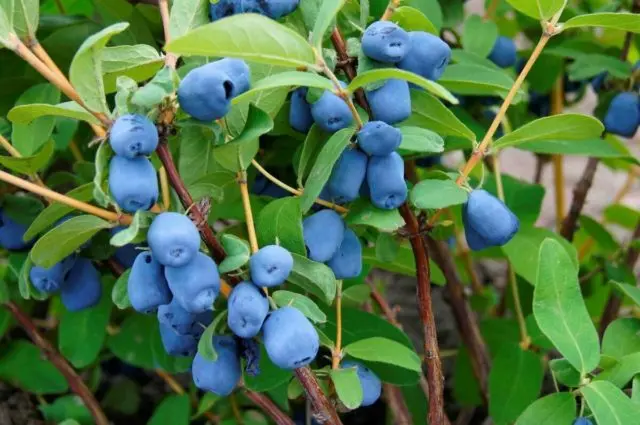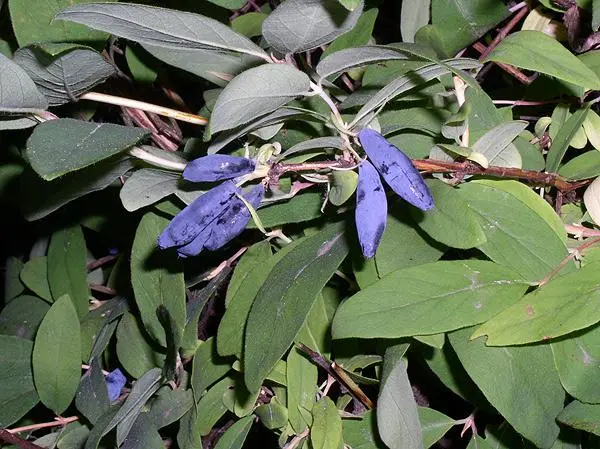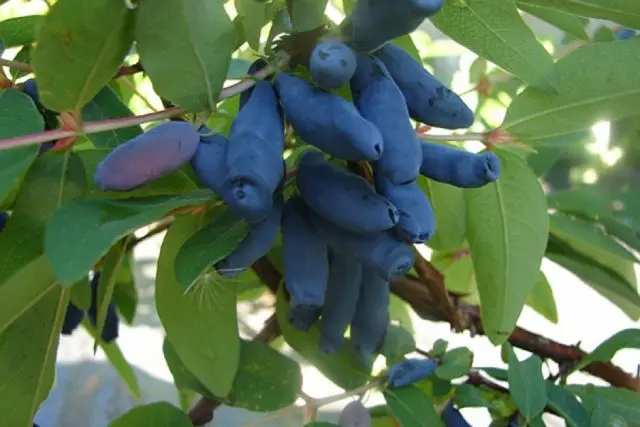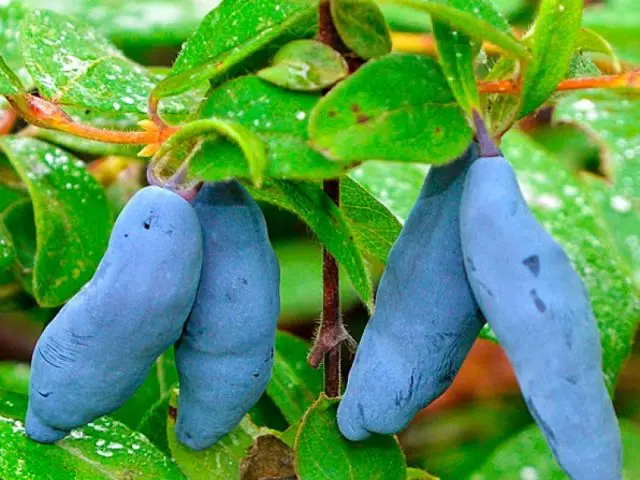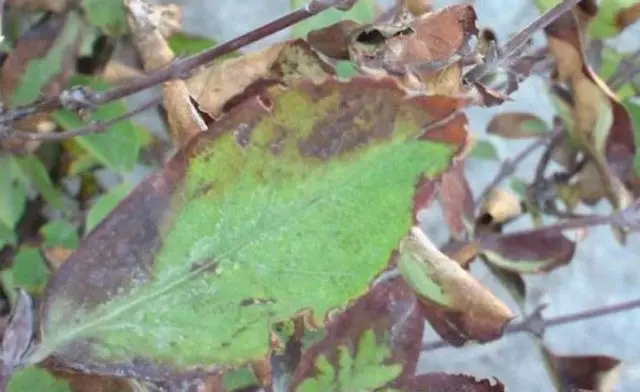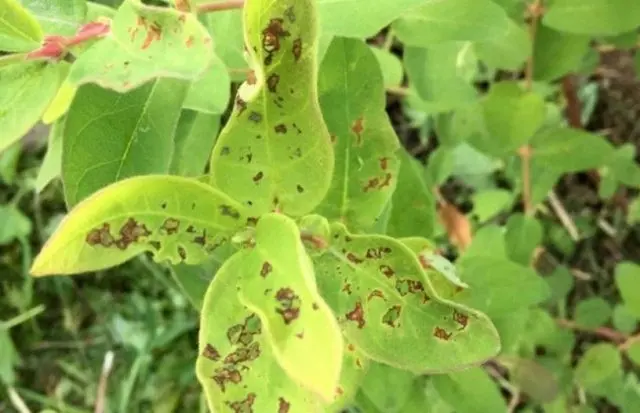Contents
Honeysuckle “Vasyuganskaya” (Lonicera caerulea Vasuganskaya) is a perennial shrub that was bred by the method of free pollination of Turchaninov’s honeysuckle (its elite form No. 68/2). The variety is named after the Vasyugan River, which flows in the southwestern part of Siberia. The plant has been under state control since 1988. Description of the variety and reviews of Vasyuganskaya honeysuckle indicate its main advantages – healthy, tasty fruits and decorative beauty of shrubs.

Honeysuckle can grow up to 1,8 m in height
Description of honeysuckle Vasyuganskaya
The plant has the shape of a bush with a rounded crown, reaches a height of 1,6-1,8 m. The shoots are thin and flexible, slightly pubescent, red-brown in color (the young have a dark green tint). The leaves are green and medium-sized, lanceolate in shape, with a margin below. The flowers of Vasyuganskaya honeysuckle are pale yellow, with long stamens and a light aroma. They are located in inflorescences of 3-5 pieces on the tops of the shoots.
The fruits are cylindrical in shape, dark blue or purple. The size of the berry is 1,5-2,2 cm in length, weight is up to 1,8-2 g. The peel is thin, with a matte coating. The pulp of dense structure, has sweet and sour taste without bitterness. The yield of the Vasyuganskaya variety is up to 3-4 kg from one adult bush. After ripening, the berries fall off.
Planting and caring for honeysuckle Vasyuganskaya
Honeysuckle “Vasyuganskaya” is an unpretentious and frost-resistant variety. The optimal climate is temperate, but with proper care, the plant can also develop in the southern regions of the country. The soil should be loamy or sandy, with neutral acidity. If the soil is sandy, before planting it is necessary to enrich it with manure and peat. Chalk, lime mortar or dolomite powder should be added to acidic soil.
Planting dates for honeysuckle varieties Vasyuganskaya
You can plant Vasyuganskaya honeysuckle in spring or autumn, each method has its own advantages:
- Planting in the spring. It is carried out at the end of March or at the beginning of April. It is necessary to plant at a time when the snow has already melted, and the buds have not yet blossomed. During spring planting, it is possible to monitor the development of the bush, and, if necessary, intervene in the process (feed or cure the disease).
- Planting in the fall. It is held in late September or early October, before the first frosts. When planted in autumn, the plant undergoes stratification (hardening process), due to which it becomes hardy and strong.
When choosing a season for planting, one must take into account the climate of the region – in the northern zone, where there are early frosts, it is better to plant in spring, in the south – in autumn.

Honeysuckle “Vasyuganskaya” blooms in early May
Selection and preparation of the landing site
There should be no swamps, dirty water bodies or groundwater near the site, since excessive moisture harms the root system of the plant. It is necessary to plant on a hill so that the bushes receive enough heat and light, to avoid lowlands and ravines. Honeysuckle “Vasyuganskaya” does not like strong gusts of wind, so it is better to plant it along a hedge or fence. The landing site should be pre-cleaned of debris, old foliage and weeds.
Rules for planting honeysuckle variety Vasyuganskaya
In order for honeysuckle bushes to take root and bear fruit abundantly in the future, it is important to observe the following rules:
- The distance between the holes should be 1,8-2 m, and in rows – at least 2,5 m, the bushes should not be intertwined.
- Dig holes with a diameter of 40-50 cm and a depth of up to half a meter.
- Prepare a fertilizer mix (compost, ash and phosphate supplements) and apply it to each well.
- Deepen the root into the soil by 5-7 cm.
- Do not tamp the earth hard.
- Water the Vasyuganskaya honeysuckle seedling with warm water.
- After watering, cover the hole with mulch.
For planting, choose only healthy seedlings. Roots should be flexible and intact, with no moldy smell. Make sure that the shoots are strong and there are no pruned shoots.
Watering and feeding
Honeysuckle “Vasyuganskaya” is a moisture-loving variety, but excessive moisture can lead to rotting of the root system. It is necessary to water the bushes at the root when the soil around is slightly dry. In hot weather, watering should be increased, and excluded on rainy days. The best time is early morning or evening after sunset.
When planting, the plant receives enough fertilizer for development, so it is necessary to resume top dressing in the 2nd year of growth. At the beginning of spring, organic fertilizers are applied (manure, peat, silt, compost or use a universal mixture). Nitrogen-rich fertilizers are added to weak soil. During flowering, it is useful to add ash (1 liter per 1 bucket of warm water) – this mixture increases the yield. Adult bushes are fertilized with a solution of urea in the spring.
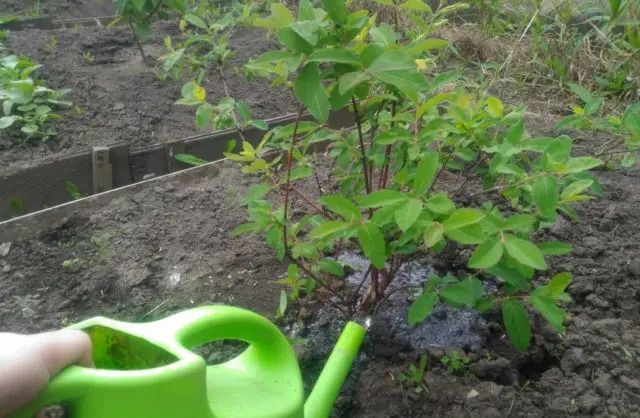
In the spring, you need to apply organic fertilizer under each bush
Pruning honeysuckle varieties Vasyuganskaya
For the first 3-5 years of development, only dry shoots or unnecessary shoots that have appeared near the base should be cut off in order to give the plant a beautiful shape. The upper branches of Vasyuganskaya honeysuckle cannot be touched – future fruits are tied on them.
At 8-10 years of age, fruiting decreases, then thinning of the crown is carried out, when the upper shoots should be partially cut off. The plant recovers quickly, after which flowering resumes, and the yield increases again.
The plant begins to bear fruit in the 2nd year of life.
Wintering
Honeysuckle “Vasyuganskaya” can withstand frosts down to -40 ° C, but the plant must be properly prepared for winter. For this you need:
- Clear the soil of debris and foliage to avoid the appearance of harmful insects.
- Feed the soil with potassium-phosphorus mixtures or organic matter.
- Remove dry shoots from the bushes, cutting them to the ground.
- Remove supports from long branches, gently bend them to the ground.
During the winter, it is recommended to cover the honeysuckle bushes with mulch (hay, straw), spruce branches or covering material (geotextile, lutrasil, and others). If the region has mild winters and frosts down to -15-20 ° C, honeysuckle can not be covered.
Honeysuckle pollinators Vasyuganskaya
Honeysuckle “Vasyuganskaya” is a self-fertile variety. He needs pollination (allogamy) in order for the ovaries to form, and subsequently the plant bears fruit. For cross-pollination, it is necessary to plant nearby bushes of honeysuckle of a different variety. Breeders recommend the following crops:
- Blue bird.

- Blue spindle.

- Tomichka.

- Daughter of the Giant.

You can plant other varieties separately in a row or alternate bushes of different crops. It is important to keep a distance between them so that the plants do not interfere with each other’s development.
Reproduction
The best way to propagate honeysuckle “Vasyuganskaya” is to divide the bush. To do this, you need to choose a strong young plant (3-5 years old), from which a good harvest has already been harvested, and carefully divide it without damaging the roots.
The second way is to use cuttings. Well-developed vertical or horizontal shoots should be cut from the plant. Usually not all specimens take root, up to 50% of specimens die.
Honeysuckle seeds “Vasyuganskaya” germinate well and develop quickly. But with this method, the plant does not inherit the parental genes, since the variety is self-infertile. The bush can grow, but will not bear fruit, but will serve only as an additional landscaping of the site.
Diseases and pests
Common pests of Vasyuganskaya honeysuckle are scale insects, mealybugs, aphids, fingerwings and others. To get rid of dangerous insects, the bushes must be treated with a solution of urea (you can still use manganese, tobacco infusion, ash or hot pepper). For prevention, 2 times a year, in spring and autumn, use Lepidocid, Confidor or their analogues.
The main causes of diseases in honeysuckle are high humidity or improper care. The variety is resistant to diseases, but when the first signs appear, it is important to take action immediately. There is a risk of such infections:
- Sooty and other types of mold fungus. It affects the foliage – first dark spots appear, after which the entire leaf turns black. When a disease appears, it is necessary to spray the plant with a 1% solution of copper sulfate or Bordeaux mixture, or treat it with antifungal drugs (Fitover, Fundazol, Topaz).

- Powdery mildew. A white coating appears on the leaves. Affected foliage should be removed immediately. Treat the plant and the soil near it with solutions of manganese or mustard, or use industrial preparations – Vitarol, Previkur, Skor and others.

- Mottled leaves. An infection that leaves yellowish spots in the form of an arc on the leaf plates. If symptoms are detected, it is necessary to remove and burn the affected branches, and treat the bushes with Fitolavin or Rapsol. If the spots reappear, the plant should be dug up and destroyed, it can only be cured at an early stage.

Viral diseases such as cucumber and rezuha mosaic, potato virus and others cannot be cured. The affected bush is destroyed so that plants in the neighborhood do not become infected.
Conclusion
Description of the variety and reviews of honeysuckle Vasyuganskaya indicate that this culture is photophilous, frost-resistant and gives a rich harvest. If you follow the rules of planting and care, then the shrubs will bear fruit abundantly and will become an adornment of any garden.










